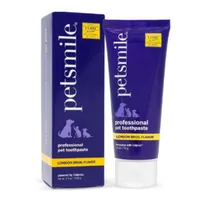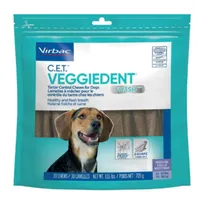How to brush a dog’s teeth: A vet’s guide
Knowing how to brush a dog's teeth is a must if you're a dog parent. This guide lays out everything you need to know to keep your pup's teeth in top shape.
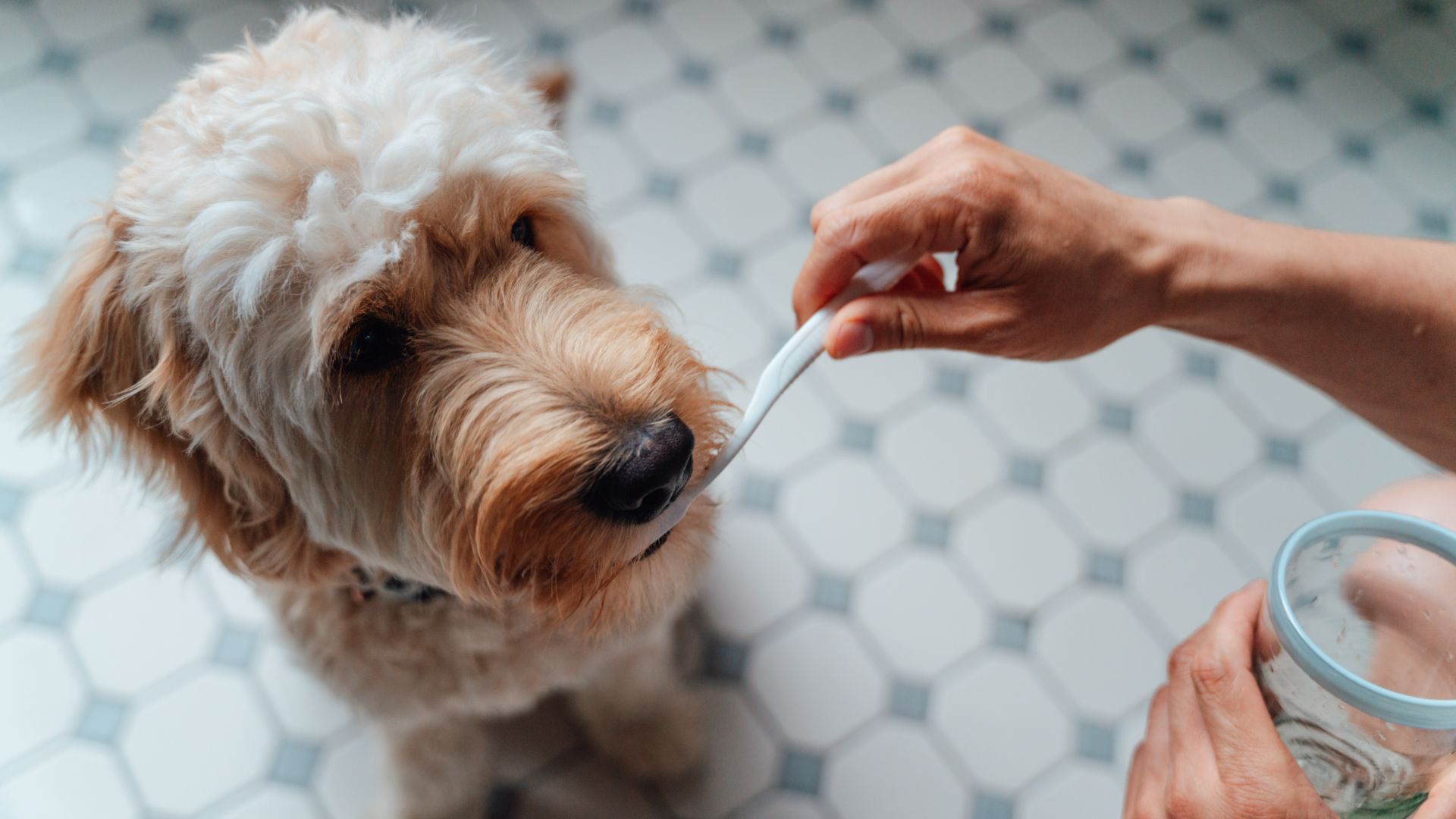
When you know how to brush a dog’s teeth you can combat things like bad breath, plaque build-up, and even prevent dental diseases. It is recommended to brush your pup’s teeth daily to ensure they are in the best shape possible.
Luckily, there are a few tools you can use to help you maintain your dog’s teeth. Things like one of the best dog toothbrushes and the best dental chews for dogs will be handy tools to keep on hand.
Brushing a dog’s teeth may seem overwhelming, but don’t worry this vet guide will help you every step of the way. Now, let’s find out all the tips and tricks for brushing your dog’s teeth.
How to choose products to brush your dog’s teeth
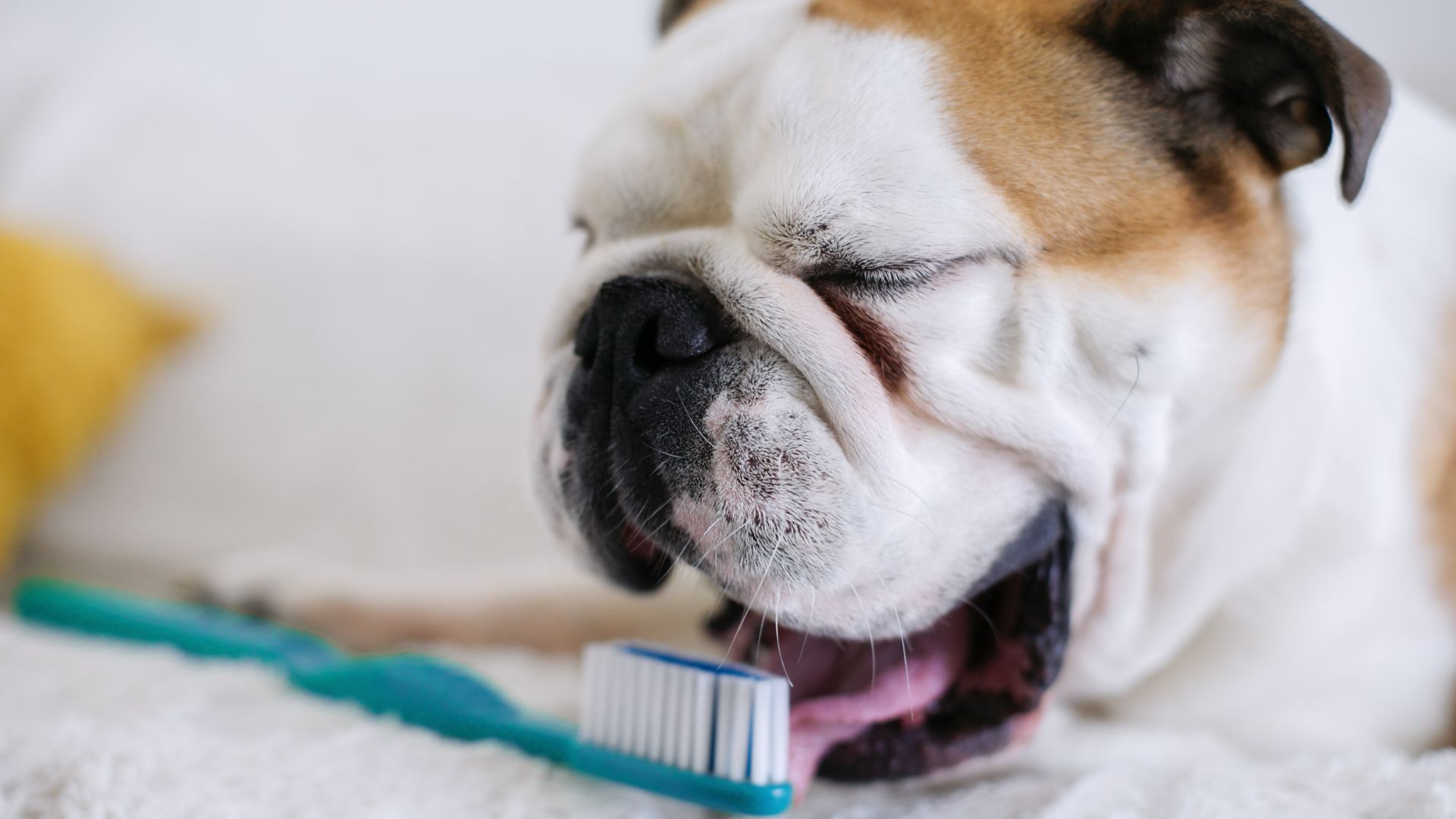
When you start brushing your dog’s teeth, make sure you choose products that are specifically made for pets. Human toothpaste is not intended to be swallowed, so it should never be used for a dog – your dog doesn’t know how to spit it out! Instead, look for pet-specific toothpaste at your local pet store or online, or ask your vet for a product recommendation. Pet toothpaste comes in many flavors, so you’ll be sure to find something your dog will enjoy!
Petsmile Professional Natural London Broil Flavor Dog Toothpaste
This toothpaste is for both dogs and cats and requires minimal effort. You simply put it on their tooth and their tongues do the rest of the work.
Choosing a toothbrush for your dog is mostly a matter of personal preference. When you’re first starting out, you may find it easiest to simply put the toothpaste on your finger and use that like a toothbrush to gently scrub your dog’s teeth.
If you’ve never brushed your dog’s teeth before, try experimenting with the different options to find which one is most comfortable for both you and your dog.
Can you use a human toothbrush on a dog
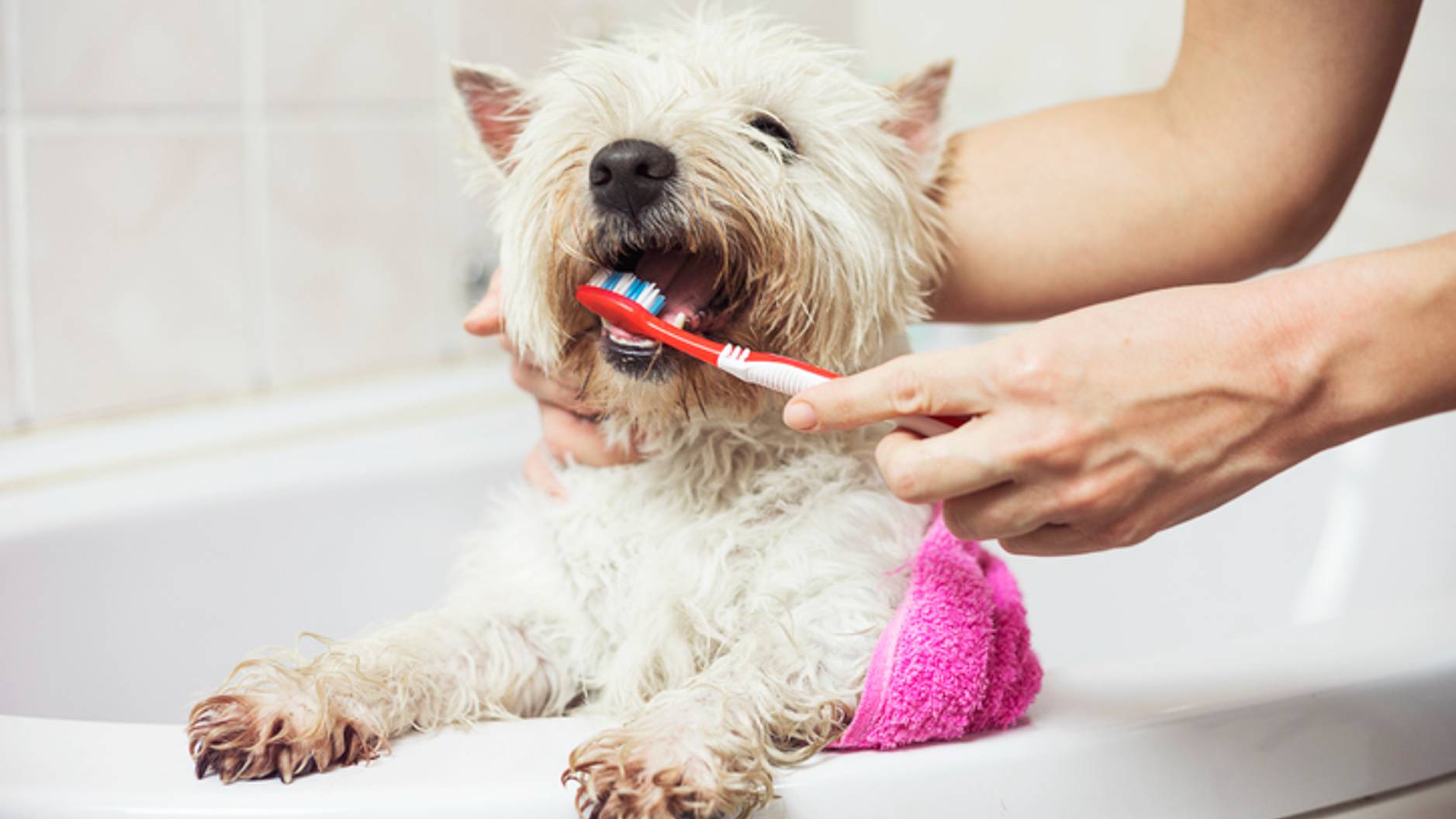
Yes, you can use a human toothbrush, or a finger brush if you prefer, on your dog, but you should never use human toothpaste. Human toothpaste is not safe for pets. Always use pet-specific toothpaste when brushing your dog’s teeth.
Get the best advice, tips and top tech for your beloved Pets
Human toothbrushes, however, are perfectly fine to use for your pup, although some pet owners prefer to use a pet toothbrush that has a shorter handle and is easier to maneuver. Whichever type of toothbrush you choose, be sure to apply the right amount of gentle pressure as you brush your dog’s teeth.
Too much scrubbing can hurt your dog and cause damage to the sensitive gum tissue, while too little pressure will not clean the teeth effectively and may leave plaque and bacteria behind.
“How often should I brush my dog’s teeth,” you may be wondering. We recommend brushing your dog’s teeth every day using about the same amount of pressure as you would use when brushing your own teeth is the best way to prevent tartar and plaque from forming, so your pup has a clean and healthy mouth.
At what age should I start brushing my dog’s teeth?
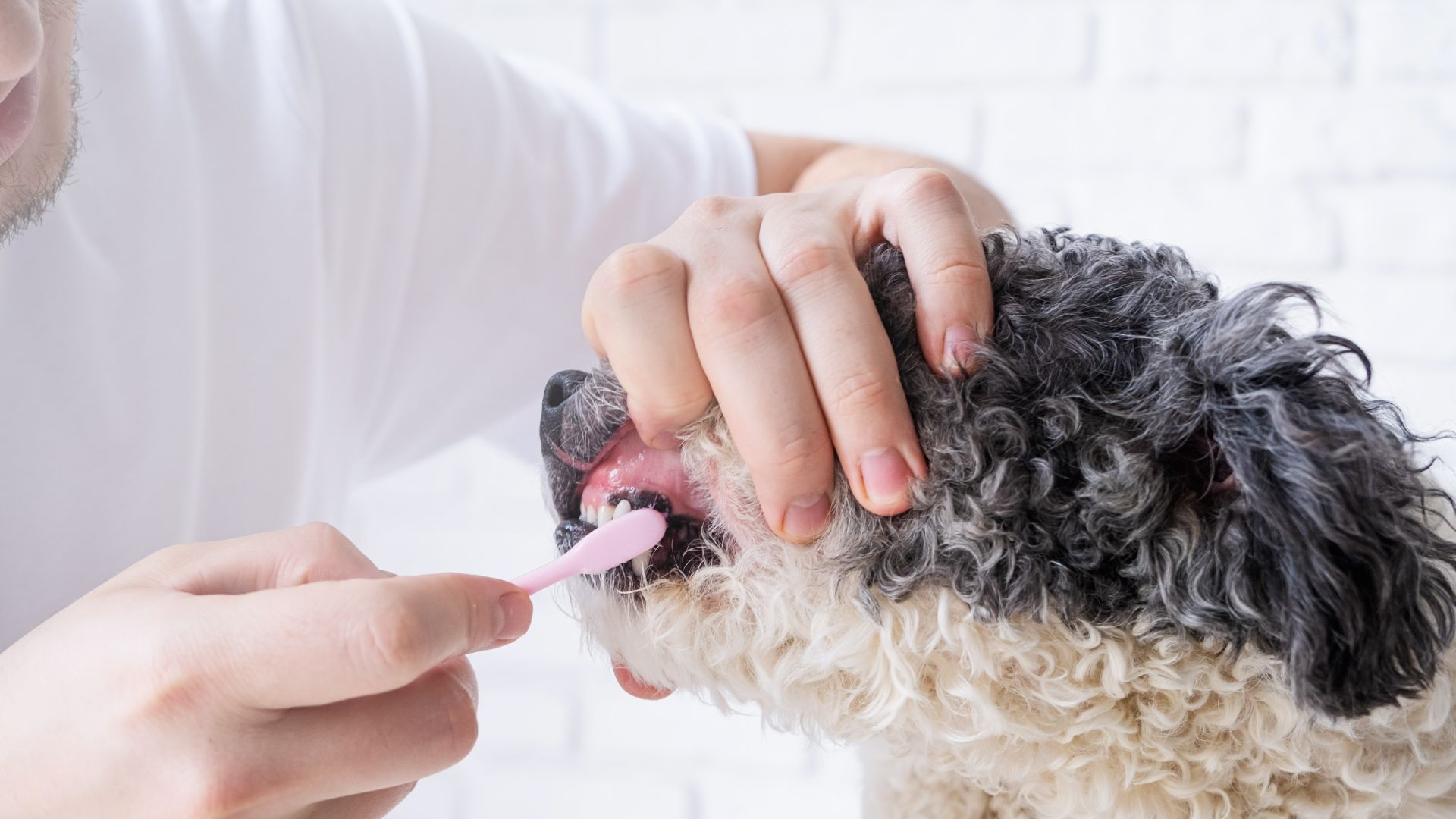
Puppies are naturally curious about the world around them and they are very open to new experiences. Puppyhood is a critical time for your dog to learn new things that he will carry with him later in life. If you can introduce your dog to the process of tooth brushing at a young age, it will be much easier to carry on this routine throughout your dog’s life.
With puppies, it is especially important to keep your brushing sessions short and positive. Any negative experiences during this time can make your puppy more resistant to brushing in the future! Give your puppy time to explore the toothbrush and toothpaste and offer lots of positive rewards. Limit your sessions to no more than a few minutes, so your puppy will always look forward to more.
How to brush a dog’s teeth

Use a gentle approach
To brush your dog’s teeth, start by allowing your dog to smell and taste the toothpaste. Once your dog is interested, put a little of the toothpaste on your finger or a toothbrush and gently lift your dog’s lip.
Carefully brush back and forth across a few teeth, then stop and allow your dog a moment to taste the toothpaste. Be sure to offer lots of praise and even a treat or two, so your dog knows that everything is okay. At first, you may only be able to brush a few teeth at a time, and that’s okay!
Over time, you can gradually work up to longer brushing sessions, until you’re able to clean your dog’s whole mouth in one sitting.
Consider the pressure
Try to focus most of your brushing along the gum line, where bacteria and food material often accumulate and cause irritation and infection. Be careful how much pressure you apply – too much and you may irritate your dog’s gums and cause bleeding or pain; too little and you may not be effectively removing plaque. Using a pressure similar to how you brush your own teeth will be effective, but you may need to give your dog time to get used to this sensation.
Establish a dental routine for your dog
Brushing your dog’s teeth is the best way to prevent dental disease. Ideally, your dog’s teeth should be brushed at least once a day. But if your dog is not ready for that yet, even brushing a few times a week is better than no brushing at all!
In addition to brushing, consider using other dental products for complete oral health coverage. Dental treats, diets, and water additives can all help prevent new plaque formation and keep your dog’s breath smelling fresh. To find the best products, look for those labeled with the Veterinary Oral Health Council (VOHC) seal, which indicates that the product has been tested and proven to reduce plaque formation.
Don’t forget that your dog needs regular veterinary care to keep his mouth clean and healthy. Check-ups with your vet at least once a year are essential to monitor your dog’s oral health and catch potential problems early. Your veterinarian can also show you how to brush a dog’s teeth if you’re having trouble at home.
Alternatives to brushing your dog’s teeth

The best way to prevent dental disease is to brush your dog’s teeth daily. However, if your dog really will not tolerate brushing – even with a slow approach as discussed above – then there are still some options to help reduce your dog’s risk of dental disease. These alternatives are not as effective as brushing, but they can still help reduce plaque formation and prevent tartar build-up.
One of the best alternatives to brushing is to feed your dog a prescription veterinary dental diet. These diets are purchased through your vet. Prescription dental diets have been tested and proven to reduce plaque formation and prevent dental disease. Because your dog eats the food consistently every day, this is a great way to stay on top of your dog’s oral health.
Products such as treats, one of the best long lasting dog chews, and water additives are not as effective as daily brushing, but they can be a helpful alternative if brushing is not possible. Look for products labeled with the Veterinary Oral Health Council (VOHC) seal, which indicates that the product has been tested and proven to reduce plaque formation.
Virbac C.E.T. VeggieDent Fr3sh Dental Chews for Medium Dogs
Z-shape helps dogs to manage the dental chew and really gets in all those hard-to-reach areas. This vegetarian dental chew helps to freshen breath and reduce plaque.
If you found the article helpful be sure to check out our tips to prevent and treat dog gum disease and how to keep dog teeth clean and healthy.
Dr. Elizabeth Racine is a small animal general practice vet covering all things pet health and wellness. Her special interests include veterinary behavior, nutrition, and internal medicine.
As a freelance writer, Dr. Racine has written content for major companies in the industry such as the American Kennel Club, Merck Animal Health, Bayer PetBasics, Elanco, and CareCredit. In her free time, Dr. Racine enjoys playing trampoline dodgeball, hiking with her beagle Dasher, and spending time with her three mischievous cats.
- Alexis De LeaverDigital & Syndication Staff Writer
